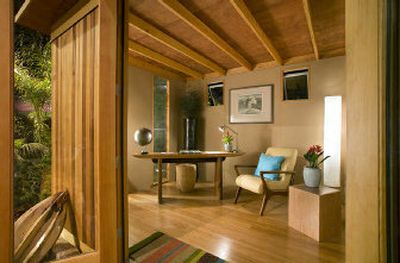Cabanas handy, Earth-friendly

While other builders are exploring ways to incorporate green building materials and techniques into big mainstream projects, Casper Mork-Ulnes and Nick Damner are thinking smaller.
Much smaller.
Their Bay Area-based business, Modern Cabana, sells little prefab structures that are made of sustainable, Earth-friendly materials. Even the insulation in the walls is made from cotton recycled from old denim jeans. Shipped in a flat pack the cabanas are designed to be put together by do-it-yourselfers using basic tools on a simple post-and-pier foundation.
“We’re striving for more sustainability all the time,” says Damner, 31, a licensed contractor. “Each one we build gets greener and greener.”
People are buying and using the contemporary cottages as home offices, yoga studios, craft rooms, kids’ playhouses, garden sheds, poolside changing rooms – and “just little getaway spaces,” says Mork-Ulnes, 33, an architect and designer.
The smallest of the cabanas is 10 feet by 10 feet and comes with standard features: dual-pane glass sliding door with screen, two rear-screened windows that open for a breeze and light-filtering polycarbonate panels on the two side walls. It costs $12,500. A slightly larger version, at 10 feet by 12 feet, costs $14,500.
Upgrade options abound. Buyers can choose thicker rigid-foam insulation in the ceiling (an inch-and-a-half is standard). Insulated clear glass panels can replace the polycarbonate. French-style doors can replace the slider. Sustainable bamboo flooring is a choice over the standard oriented strand board. There’s even a small heat pump that can be installed to warm the cottage in winter and cool it in summer.
“The inspiration for this came when we were working on a project for a custom home in Marin County, and the client needed a little space to live in while the project was being permitted,” Mork-Ulnes says. “We started looking for prefab small structures that we could get our hands on right away and found no good alternatives in the market.”
Says Damner: “Most of the shed structures we looked at were not very aesthetically appealing, to say the least. They were utilitarian. We were looking for something that had a more residential look.”
Last June, the two men – they’re brothers-in-law – launched Modern Cabana in a 4,500-square-foot warehouse on Potrero Hill in San Francisco. After a mention in the ultra-hip, green-focused Dwell magazine, the business started to take off. And then thousands of visitors to this year’s San Francisco Flower and Garden Show stepped inside a Modern Cabana – a 10-by-12-foot cutie tricked out with all the available bells and whistles – in a garden by East Bay designer Daniel Owens.
At the show, San Jose designer Alrie Middlebrook took one look at the structure and knew it would be perfect in the backyard of a native-plant garden she was working on in Willow Glen. She bought it on the spot. Her client – Middlebrook says he is “really committed to living lightly on the Earth” – intends to use it as a martial arts studio.
“This one was a little unusual in that the homeowner wanted it built on top of a semi-underground storage area,” says Damner, who oversaw the dismantling of the cabana and its “deployment” and rebirth in San Jose after the storage area-foundation had been built. Today, the cabana perches over the garden, reachable by a short flight of steps made of recycled-plastic lumber.
Outside the Bay Area, Modern Cabanas have been “deployed” as far away as Austin, Texas. They’ve also had calls from people interested in having a cabana installed on a roof, “but so far, no one’s been gutsy enough to actually do it,” says Damner.
The largest cabana to date is being built in South San Francisco. When complete, the 350-square-foot structure will adjoin a deck and pool area. That one required a building permit because of its size; most cabanas don’t.
The prefab panels are manufactured with spaces for wiring to add electrical and phone lines. For permanent wiring, homeowners must contract with a licensed electrician to have that part of the project completed to meet local codes.
The “Cabana Boys” say that business is brisk and that customers continue to dream up novel uses for their little buildings.
“One guy told us his wife wanted to put his billiards table in one,” Damner says, “and the other one is being used as a cigar room. A lot of this seems to be about getting the husband out of the house.”
For more information, go to www.moderncabana.com.